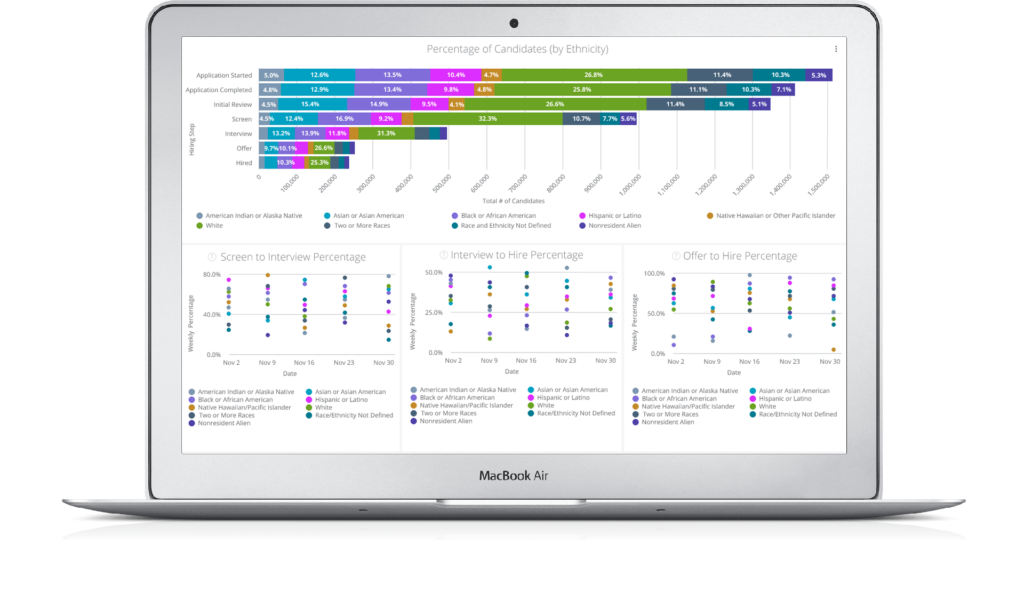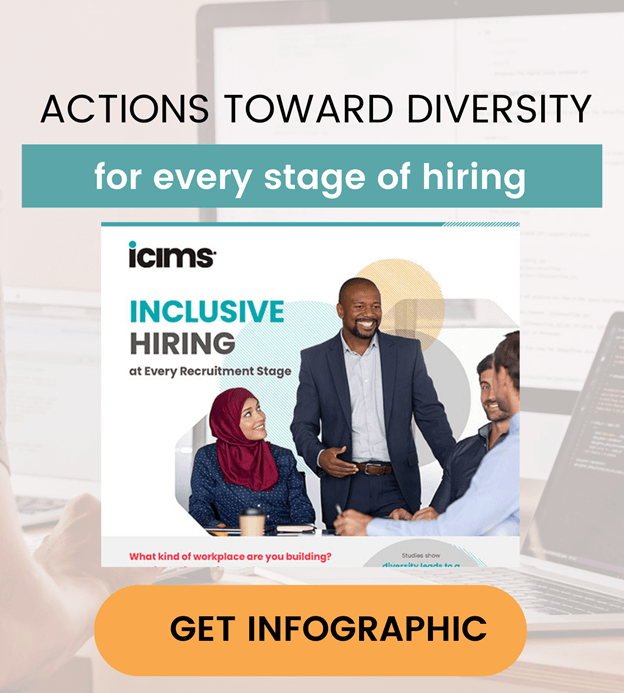- Solutions
- Products
- Community
- Resources
- Company
Create incredible candidate experiences that communicate your brand, mission, and values with recruitment marketing solutions.
Learn moreCommunicate effectively and efficiently with the candidates that can drive your business forward.
Learn moreSelect the right candidates to drive your business forward and simplify how you build winning, diverse teams.
Learn moreHelp your best internal talent connect to better opportunities and see new potential across your entire organization.
Learn moreCommunicate collectively with large groups of candidates and effectively tackle surges in hiring capacity.
Learn moreAccess tools that help your team create a more inclusive culture and propel your DEI program forward.
Learn moreRebound and respond to the new normal of retail with hiring systems that are agile enough to help you forge ahead.
Learn moreAccelerate the hiring of key talent to deliver point of care and support services that meet and exceed your promise of patient satisfaction.
Learn moreAttract and engage candidates with technical competencies, accelerate hiring for much-needed skills, and advance expertise within your valued workforce.
Learn moreSimplify how you recruit finance, insurance, and banking candidates with a unified platform built to match top talent with hard-to-fill roles.
Learn moreYour business strategy depends on your people strategy. Keep both in lockstep with the iCIMS Talent Cloud.
Learn moreBuild an engaging, high-converting talent pipeline that moves your business forward.
Learn moreDeliver the innovation your talent team needs, along with the global scale and security you demand.
Learn moreDeliver tailored technology experiences that delight users and power your talent transformation with the iCIMS Talent Cloud.
Learn moreThe #1 ATS in market share, our cloud-based recruiting software is built for both commercial and large, global employers.
Learn more Talk to salesAttract the best talent for your business with powerful, on-brand career websites that excite candidates and drive engagement.
Learn more Talk to salesCombine behavior-based marketing automation with AI insights to build talent pipelines, engage candidates with multi-channel marketing campaigns, and automatically surface the right talent for the job.
Learn more Talk to salesEmpower candidates with automated self-service, qualification screening, and interview scheduling through an AI-enabled digital assistant.
Learn more Talk to salesSimplify employee onboarding with automated processes that maximize engagement and accelerate productivity.
Learn more Talk to salesVerify skills with game-changing levels of automation and simplicity to improve the quality of hire at scale.
Learn more Talk to salesModernize, streamline, and accelerate your communication with candidates and employees.
Learn more Talk to salesTransform the talent experience by showcasing your authentic employer brand through employee-generated video testimonials.
Learn more Talk to salesSimplify recruiting, dynamically engage talent, and reduce hiring bias with job matching and recruiting chatbot technology.
Learn moreStreamline and centralize your HR tech stack with configurable, flexible, secure and reliable integrations.
Learn moreHow a beloved restaurant hires 40,000+ annually with a great candidate experience.
Learn moreThousands strong, our global community of talent professionals includes creatives, innovators, visionaries, and experts.
Learn moreTogether we’re creating the world’s largest ecosystem of integrated recruiting technologies.
Learn morePartner with our global professional services team to develop a winning strategy, build your team and manage change.
Learn moreExplore our network of more than 300 certified, trusted third-party service and advisory partners.
Learn moreUncover unique market insights, explore best practices and gain access to talent experts across out library of content.
Get resourcesExpert guidance about recruitment solutions, changes in the industry, and the future of talent.
Learn moreStay up to date with the latest terminology and verbiage in the HR software ecosystem.
Learn moreEmployers everywhere improve hiring efficiently and save money using iCIMS. Estimate the potential business value you can achieve.
Learn moreDive into the Class of 2023 Report highlighting this cohort’s expectations and where employers are willing — and able — to meet them.
Watch nowPartner with iCIMS to build the right strategies, processes, and experience to build a winning workforce.
Learn moreExpert guidance about recruitment solutions, changes in the industry, and the future of talent.
Learn moreDeliver the innovation your talent team needs, along with the global scale and security you demand.
Learn moreView press releases, media coverage, and the latest hiring data. See what analysts are saying about iCIMS.
Learn moreiCIMS is the Talent Cloud company that empowers organizations to attract, engage, hire, and advance the talent that builds a winning workforce.
Learn moreGet to know the award-winning leadership team shaping the future of the recruiting software industry.
Learn moreWe believe the future of work isn't something that "happens" to you. It's something you create. We actively create the future of work with our customers every day.
Learn moreiCIMS is committed to being a responsible and ethical corporate citizen, which is why Environmental, Social and Governance (ESG) initiatives are strategic imperatives.
Learn moreStreamline your tech stack and take advantage of a better user experience and stronger data governance with ADP and the iCIMS Talent Cloud.
Learn moreThe combined power of iCIMS and Infor helps organizations strategically align their business and talent objectives.
Learn moreOur award-winning partnership with Microsoft is grounded in a shared desire to transform the workplace and the hiring team experience.
Learn moreOur partnership with Ultimate Kronos Group (UKG) supports the entire talent lifecycle by bringing frictionless recruiting solutions to UKG Pro Onboarding.
Learn moreLet’s get in touch. Reach out to learn more about iCIMS products and services.
Learn more

We all fear the dreaded candidate response: “Thanks for considering me for this opportunity, but…”
It’s heartbreaking when a favorite candidate takes themselves out of the running. Not only that, but candidate drop-off slows your hiring, increases cost-per-hire, and is just plain stressful. As you can imagine, it gets even more complex when looking at your DEI hiring strategy. If you didn’t design your hiring process with their specific needs in mind, candidates from historically excluded groups (HEGs) might feel unwelcome.
Due to that complexity, roles for diversity-focused recruiters jumped 800% between 2017-18 and 2019-20, according to Gartner TalentNeuron™ data. Companies serious about DEI know that specialized talent acquisition professionals can ensure their hiring journey isn’t a one-size-fits-all approach.
All organizations have a responsibility to listen to those from historically excluded groups and tailor the hiring experience to their wants and needs. Plus, due to unconscious bias, there must be extra measures to ensure an equitable experience for candidates from HEGs, such as AI and anonymized resumes.
Talent from HEGs drops off for many reasons—your exclusive job description, a lengthy application process, and a lack of diversity on your interview panels. There’s plenty that can go wrong and decrease the representation in your hiring pipelines. How can you safeguard your processes to get ahead of potential pitfalls instead of reacting to problems as they arise?
It’s key to have comprehensive insights into your hiring funnel, from sourcing to advancement, so you can identify where your hiring process could be more equitable at every stage. Many organizations lack the insight to do that—or have disorganized data that takes hours, days, even weeks to organize into a useful overview. According to Korn Ferry, 53% of recruiters aren’t using all their hiring data for insights. There’s a lot of valuable information they’re leaving on the table.


It’s essential to choose an Applicant Tracking System (ATS) that provides you with the insights you need in an easily digestible way. To boost DEI outcomes, make sure you can view each funnel stage broken down by demographic so you have the data you need to act.
We at iCIMS have been using DEI Analytics to elevate our own DEI hiring program. “These are new insights for me,” said iCIMS Chief People Officer, Jewell Parkinson. “The visual displays make the data interpretation very intuitive.”
Read on for three specific ways you can use DEI Analytics in iCIMS ATS to minimize drop-off and maintain a diverse talent pipeline:
While having ATS data can help you identify areas to improve the candidate experience and reduce bias, it’s only one part of a broad set of DEI initiatives. At iCIMS, we see DEI as a holistic, candidate-first journey at every funnel stage, including better employee retention. The talent acquisition software provides you with candidate relationship management software (CRM), employee testimonial videos, beautifully branded DEI site templates, AI to reduce bias, and diversity recruiting tools.
Companies that want to become top DEI organizations need a plan in place to build an authentic candidate experience, reduce bias, retain top talent, and measure your efforts—every step of the journey.
Do you want to learn more about reducing drop-off by building an equitable DEI candidate experience? Check out our ebook Inclusive Hiring at Every Recruitment Stage.






